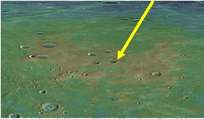The MESSENGER Education and Public Outreach (EPO) Team is reminding interested parties that the competition to name five impact craters on Mercury closes on January 15, 2015. The contest, open to everyone except members of the mission's EPO team, was launched on December 15, 2014.
NASA's MESSENGER spacecraft has been in orbit about Mercury since March 2011. The mission's EPO team is led by Julie Edmonds of the Carnegie Institution for Science.
According to the International Astronomical Union (IAU)—the governing body of planetary and satellite nomenclature since 1919—new names for craters on Mercury must be that of an artist, composer, or writer who was famous for more than 50 years and has been dead for more than three years. See the current list of named Mercury craters.
The EPO team's contest allows the public to immortalize an important person in the arts and humanities from anywhere in the world. Submissions will be accepted until January 15, 2015 (23:59 UTC). Fifteen finalist names for craters will be submitted to the International Astronomical Union (IAU) for selection of the five winners. Winning submissions will be announced by the IAU to coincide with the end of MESSENGER's orbital operations in late March or April 2015. IAU decisions will be final.
Edmonds advises participants to research the artist, composer, or writer under consideration before filling out the contest entry. "Once online, registrants will be asked to submit a short description of their chosen individual's contributions to their field, as well as an authoritative source for background information," she said.
The name cannot have any political, religious, or military significance. Nor can other features in the Solar System have the same name. For example, Ansel Adams is not eligible because there is a feature on the Moon with the name Adams (even though it was not named for Ansel). Participants can check their ideas against the list of named Solar System features and enter the name in the "Search by Feature Name" box in the upper right corner.
The MESSENGER spacecraft has far surpassed expectations both in the duration of the mission and in the quality and quantity of data. The mission will end this spring as the tiny craft succumbs to gravity and impacts on Mercury. The EPO team organized the competition to celebrate the mission's achievements.
The original goal of MESSENGER was to take 2,500 images of the planet, but is has returned more than 250,000 images. "We now have a detailed, high-resolution map of the entire planet," Edmonds noted. "As scientists study the incredible data returned by MESSENGER, it becomes important to give names to surface features that are of special scientific interest. Having names for landforms such as mountains, craters, and cliffs makes it easier for scientists and others to communicate."
More information: Enter the contest online at namecraters.carnegiescience.edu/
Provided by Carnegie Institution for Science
























